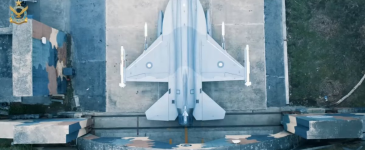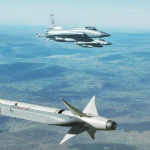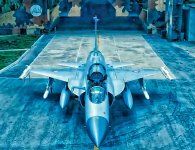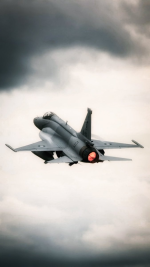Comparison of the JFT with the M-2k
JF-17 and Mirage-2000 Mirage 2000:
The Mirage 2000 is a versatile multirole fighter that has served the Indian Air Force (IAF) since the 1980s. It is equipped with a range of sophisticated weapon systems, making it effective in both air-to-air and air-to-ground roles. The Mirage 2000’s primary air-to-air weapon is the MICA missile, which comes in both infrared (IR) and radar-guided variants, providing the aircraft with reliable beyond-visual-range (BVR) and close-combat capabilities. In air-to-ground roles, the Mirage 2000 can carry precision-guided munitions such as laser-guided bombs and the SCALP-EG cruise missile, which allows it to perform deep-strike missions with high accuracy. Its multirole capabilities make it a key asset in the IAF's inventory for various mission profiles, from air superiority to ground attack. JF-17 Thunder:
The JF-17 Thunder, developed by Pakistan in collaboration with China, is designed to be a cost-effective multirole fighter capable of performing a wide array of combat missions. The JF-17 can carry a variety of weapon systems, including air-to-air missiles, air-to-ground munitions, and anti-ship missiles. For air-to-air combat, the JF-17 is equipped with the SD-10 and, more recently, the PL-15 missile, which enhances its BVR combat capabilities significantly. In ground attack roles, the JF-17 can deploy precision-guided bombs, rockets, and anti-ship missiles, allowing it to effectively engage a variety of targets. The JF-17’s ability to integrate both Chinese and Western munitions provides it with a high degree of operational flexibility, making it a versatile platform for the Pakistan Air Force (PAF). BVR Capability Mirage 2000:
The Mirage 2000’s primary BVR missile, the MICA, has a range of approximately 60-80 kilometers, depending on the variant and engagement conditions. While the MICA is a reliable and proven missile with good maneuverability and multi-target engagement capabilities, its range is somewhat limited compared to the latest generation of BVR missiles. The Mirage 2000’s radar system, though capable, may also have a shorter detection and tracking range compared to the JF-17’s newer systems, potentially putting it at a disadvantage in BVR engagements.
JF-17 Thunder with PL-15s:
The JF-17’s BVR capability has been significantly enhanced with the integration of the PL-15 missile, which has a reported range of over 200 kilometers, far surpassing the range of the MICA used by the Mirage 2000. This extended range allows the JF-17 to engage targets from a much greater distance, giving it a substantial advantage in BVR combat. The JF-17’s radar, particularly the KLJ-7A AESA variant, also offers superior detection and tracking capabilities, enabling it to effectively use the PL-15’s long-range potential. In a BVR scenario, the JF-17, armed with PL-15 missiles, would likely be able to detect and engage the Mirage 2000 long before the latter can respond, giving the JF-17 a clear tactical edge in air-to-air combat. Instantaneous Turn Rate (ITR) and Sustained Turn Rate (STR) Mirage 2000:
The Mirage 2000, with its delta-wing design, is known for its excellent instantaneous turn rate (ITR), which allows it to quickly change direction and gain an angular advantage in a dogfight. This high ITR gives the Mirage 2000 an edge in the initial stages of air combat maneuvering (ACM), allowing it to quickly point its nose toward the enemy for a potential missile shot or gun attack. However, the delta-wing configuration also results in a lower sustained turn rate (STR), meaning the Mirage 2000 may lose energy more rapidly during prolonged turning engagements, limiting its ability to maintain high-speed, tight turns over extended periods.
JF-17 Thunder:
The JF-17’s design incorporates a more conventional wing and tail configuration, which provides a balanced performance in both ITR and STR. While the JF-17’s ITR might not match the Mirage 2000’s initial agility, its STR is generally superior, allowing it to sustain turns longer and with less energy loss. This superior STR gives the JF-17 an advantage in prolonged dogfights, where maintaining energy and speed is crucial for outmaneuvering the opponent. In air combat maneuvering, the JF-17 would likely employ tactics that emphasize its ability to sustain turns and maintain energy, potentially forcing the Mirage 2000 into situations where it loses energy and becomes vulnerable. In a comparison of combat effectiveness, the JF-17 Thunder emerges as a formidable opponent to the Mirage 2000, particularly in BVR engagements where its PL-15 missiles significantly outrange the MICA missiles of the Mirage 2000. The JF-17’s superior radar capabilities and extended missile range would allow it to engage the Mirage 2000 from a distance, potentially neutralizing the threat before the Mirage can effectively respond. In close-range combat, while the Mirage 2000’s excellent ITR gives it an initial edge, the JF-17’s better STR and energy management could allow it to outlast the Mirage in prolonged dogfights, turning the engagement in its favor.












